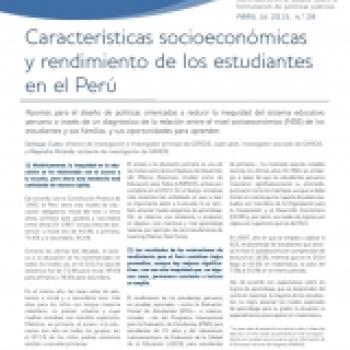Publication Information

This brief (in Spanish) presents recent analysis from Young Lives of the links between children's socio-economic status (household poverty level, parental education, ethnicity and gender) and levels of learning and achievement at school. Historically, inequality in education has been linked to access to school, but with recent improvements in enrolment, this trend is shifting rapidly towards inequality in learning.
The test results achieved by school children in Peru in several different surveys show a combination of low scores (although these are improving) and high inequality among different groups of children. Results both in national tests (such as the Census Evaluation of Students) and international tests (e.g. the Latin American Laboratory for Assessment of the Quality of Education at elementary level and the Programme for International Student Assessment for students aged 15) have shown significant improvements in recent years, although most students are not achieving the levels of learning expected within the national curriculum (and are particularly worrying in mathematics).
However, when we analyse gaps between groups, we find that the differences between boys and girls are small (with boys doing better in maths and girls in reading) compared to other forms of grouping. The gap between private and public schools has decreased in recent years, possibly because of the increasing number of private schools of low quality, but the gap between urban and rural has remained at similar levels or even increased, as well as the gap between complete and multi-grade schools (schools where students from different grades attend the same classroom).
While education should be an instrument for quality and equality, longitudinal data from Young Lives suggests that Peru's education system seems to be reinforcing rather than decreasing socio-economic inequalities. The distribution of investment and resources in schools should compensate for differences between groups of students, but the schools attended by children from better-off households, in urban areas, or whose mother is from a Spanish-speaking background receive more or better resources. Public urban and private schools are more likely to have libraries, rooms for workshops and laboratories for science than rural schools (attended by more poorer students), and similar results were found for basic services. Young Lives and other studies have shown that poorer students attend schools with lower-quality teaching and teachers often had poorer content knowledge (maths), and were less likely to give adequate feedback to their students.
The brief gives an assessment of positive trends in recent education policy and makes some concrete recommendations for improvements that could be made.

This brief (in Spanish) presents recent analysis from Young Lives of the links between children's socio-economic status (household poverty level, parental education, ethnicity and gender) and levels of learning and achievement at school. Historically, inequality in education has been linked to access to school, but with recent improvements in enrolment, this trend is shifting rapidly towards inequality in learning.
The test results achieved by school children in Peru in several different surveys show a combination of low scores (although these are improving) and high inequality among different groups of children. Results both in national tests (such as the Census Evaluation of Students) and international tests (e.g. the Latin American Laboratory for Assessment of the Quality of Education at elementary level and the Programme for International Student Assessment for students aged 15) have shown significant improvements in recent years, although most students are not achieving the levels of learning expected within the national curriculum (and are particularly worrying in mathematics).
However, when we analyse gaps between groups, we find that the differences between boys and girls are small (with boys doing better in maths and girls in reading) compared to other forms of grouping. The gap between private and public schools has decreased in recent years, possibly because of the increasing number of private schools of low quality, but the gap between urban and rural has remained at similar levels or even increased, as well as the gap between complete and multi-grade schools (schools where students from different grades attend the same classroom).
While education should be an instrument for quality and equality, longitudinal data from Young Lives suggests that Peru's education system seems to be reinforcing rather than decreasing socio-economic inequalities. The distribution of investment and resources in schools should compensate for differences between groups of students, but the schools attended by children from better-off households, in urban areas, or whose mother is from a Spanish-speaking background receive more or better resources. Public urban and private schools are more likely to have libraries, rooms for workshops and laboratories for science than rural schools (attended by more poorer students), and similar results were found for basic services. Young Lives and other studies have shown that poorer students attend schools with lower-quality teaching and teachers often had poorer content knowledge (maths), and were less likely to give adequate feedback to their students.
The brief gives an assessment of positive trends in recent education policy and makes some concrete recommendations for improvements that could be made.

